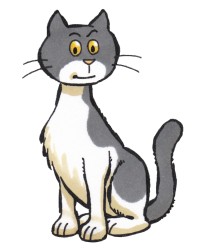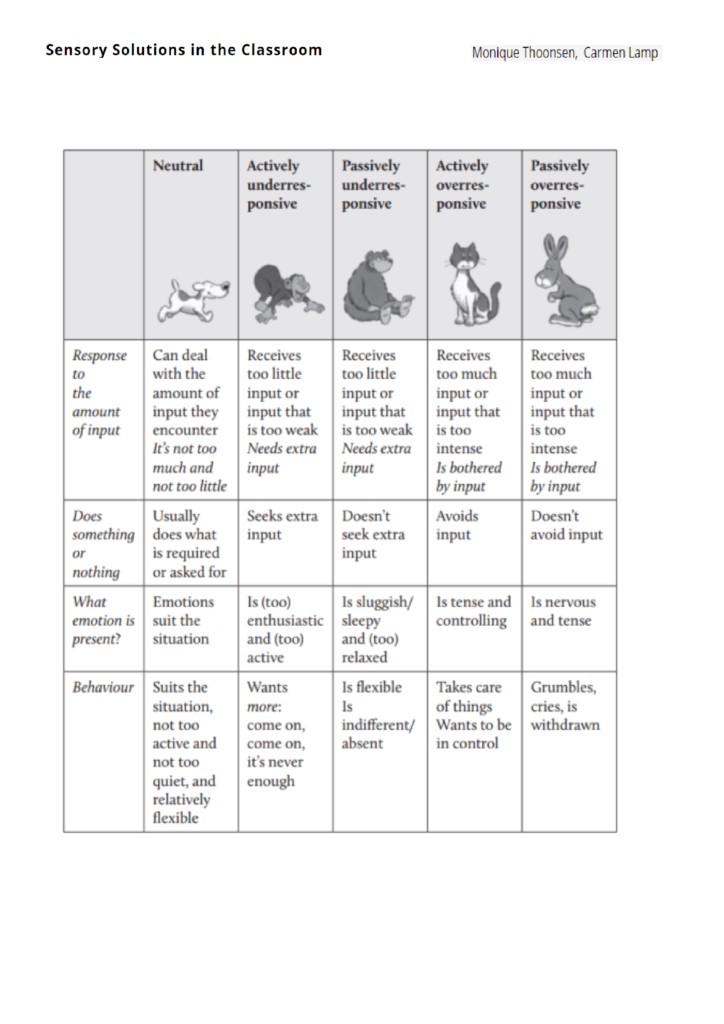The five types
Sensory types
Below we explain the five different sensory processing ‘types’. You can recognize a type by looking at a person’s behavior, because this will give clues as to their way of sensory processing. We call that: looking through the SPi-glasses (Sensory Processing-glasses). With the SPi-glasses on you can see that some people have problems processing sensory input.
The four types -the ones which deviate from the first type, which is neutral- were developed by Winnie Dunn (Dunn’s model of sensory processing, 1997). She was the first to describe these four different profiles of sensory processing.
You can download and use an overview of characteristics (with reference to the source). In this document you will also find an addition of behavior that you can see in people with intellectual disabilities when they are under or overstimulated. Download here the List of type of behaviors of the four types.
Too little or too much sensory input
The first 4 types all have a different way of dealing with their problematic sensory processing, they differ from the average (the average of neutral sensory processing). You may differ by either being aware of too little sensory input (much of this input is labeled as ‘boring’ by the brain) or being aware of far too much input (far too much input is labeled ‘VIP’ and ‘interesting’ ). You can see from behavior whether people are looking for input, avoid it or actually do nothing about receiving the wrong amount of input.
To make the differences clearer, we have created quite extreme types. With practice you will start seeing the nuances. Mixed types do also occur, so you may recognize yourself or people around you in multiple types.
Click on the different tabs to the right to view all sensory types.
Underresponsive and Active
Busy, spontaneous, exuberant/chaotic, requires a lot of attention, goes on and on. (is actively trying to get more input)

Because too little input is passed on to the brain’s cortex, this person does not receive enough signals that something is wrong or something needs to be done. As a result, this person remains somewhat sluggish or sleepy. As long as he doesn’t do anything about it, that is. But that is not the case with this first type, because he certainly does something about the lack of input:
The underresponsive and active person looks for additional sensory input. This person seeks input that lasts longer, is more intense and is repeated more often. So they don’t tire of input quickly; because sensory input─ lots of input─ is just what they need!
What is typical?
This person
- would like more intense input and above all many new experiences;
- is ‘always on the go’;
- likes to visit or go to parties, festivals, the fair;
- doesn’t much like routines and rules, always the same is boring;
- likes bright colors and spicy flavors;
- is very enthusiastic and impulsive, sees possibilities everywhere;
- prefers to learn with the radio on and moving around;
- finds it difficult to attune to others, notices their needs less;
- gets impatient when things are calm, gets bored easily;
- is sometimes so active that concentrating on one thing is difficult;
- cannot function well in an environment with little input;
- needs to be called to task, is often busy with other things.
Underresponsive and Passive
Flexible and sluggish, indifferent, lacks information, is hard to reach. (not trying to get more sensory input)

Because too little input is passed on to the brain’s cortex, this person does not receive any signals that something is wrong or something needs to be done. As a result, this person remains somewhat sluggish or sleepy. And this second type does nothing about that:
The underresponsive and passive person does not go looking for the extra input he needs. As a result, he remains sluggish and misses information. When input does come his way, he can enjoy it.
What is typical?
This person
- is calm and very flexible, most things don’t bother this person much;
- can concentrate well, is not easily distracted;
- is not aware that he is missing information;
- does not get upset easily;
- performs well under pressure (doesn’t notice it much);
- has the peace of mind to think things through;
- can focus well even while in a busy crowd;
- seems uninterested;
- is regularly slow and forgetful;
- sometimes misses important information, such as his name when being called upon;
- needs to be called upon to pay attention, misses instructions;
- lacks a broad view to be able to plan well.
Overresponsive& Active
Structured and decisive, with an eye for detail, tenses easily, wants to be in control (calming themselves)

Because too much input is passed on to the brain’s cortex, this person is flooded with input. It is therefore difficult to filter out the input that is most important at that moment.
The overresponsive and active person tries to influence the amount of input in the environment so that they do not become overloaded with input all the time. They try to avoid unpleasant input and look for input that calms them.
What is typical?
This person
- creates routines and rituals to manage the day;
- can plan and create structure very well;
- enjoys spending time alone;
- doesn’t forget something quickly;
- notices everything;
- prefers to eat things with familiar, subtle flavors;
- prefers to learn according to a fixed structure, clear planning and with calmness surrounding them;
- is inflexible;
- wants to control how things go;
- is easily bothered by others;
- can get quite emotional;
- resists change.
Overresponsive & Passive
Sensitive, perceptive, nervous, likes calm, can suddenly become upset (not calming themselves)

Because too much input is passed on to the brain’s cortex, this person is flooded with input. It is therefore difficult to filter out the input that is most important at that moment.
The overresponsive and passive person is not much concerned with influencing the amount of input in their environment, as a result of which they regularly become overloaded with sensory input.
What is typical?
This person
- generally notices any sensory input as it occurs;
- has a great awareness of their environment;
- has an eye for detail;
- works well alone;
- knows what someone needs;
- knows where things are and remembers what people say;
- learns best when there are no distractions;
- is easily distracted;
- may grumble or cry a lot (about being bothered by sensory input);
- is flexible but does not see the consequences of being flexible (and saying yes to too many things);
- feels uncomfortable with much and intense input;
- is hyper and nervous; they easily startle because they did not expect input.
The ‘neutral’ type
Experiences sufficient input to be guided by it and usually is not bothered by sensory input

There is of course also a ‘neutral’ type. This is when a person is under- or overresponsive to sensory information. They adjust their behavior based on the sensory information they receive:
- When they are feeling hot, they adjust the amount of clothes they are wearing or open a window.
- When it’s too dark to read, they turn on more light.
- When food has an unexpected taste, they spit it out.
- When they threaten to lose their balance, they extend an arm or leg to restore balance.
When sensory processing works quite well, people will not be bothered by sensory input and will receive sufficient input to act upon it. So despite a huge amount of input, they filter the relevant information from it and can ignore the unimportant input.
Different types
Click on the image to download an overview of the different types.

